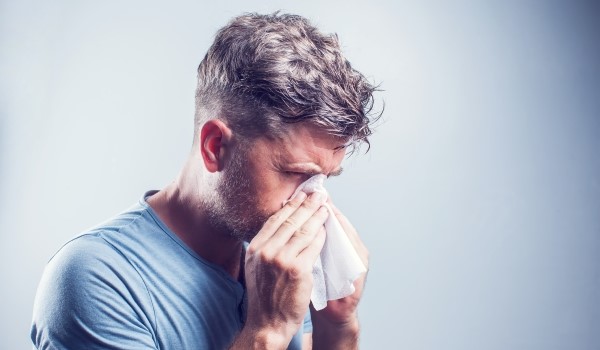What exactly is a
House dust mite allergy?
A house dust mite allergy is an allergic reaction to tiny microscopic arachnids that live in dust and house dust. The allergic reaction is triggered by contact with the excrement and body fragments of the mites and can cause symptoms such as sneezing, rhinitis, coughing, skin rashes and breathing difficulties. Appropriate cleaning and allergy medication can help to provide relief.
About the symptoms
More information
Important facts about house dust mite allergy
Symptoms of a house dust mite allergy
- Sneezing and runny nose
- Stuffy nose and nasal breathing difficulties
- Itchy, reddened or watery eyes
- Cough and breathing difficulties
- Skin rashes, eczema or itching
- Impaired quality of life due to frequent symptoms
- Sleep disturbances due to a night-time cough or blocked nose
- Exacerbation of asthma symptoms in asthmatic patients
House dust allergy vs. hay fever
Compared to a pollen allergy (hay fever), the symptoms of a house dust mite allergy are generally milder, although they persist throughout the year. The symptoms are particularly severe at night and in the morning, as there is a high concentration of house dust mites in mattresses, pillows, blankets and comforter covers. These tiny arachnids can trigger the allergic reaction through their excrement and body fragments.
What are the causes and forms of house dust mite allergy?
The causes and risk factors for a house dust mite allergy can be varied.
Allergic symptoms occur when the body reacts hypersensitively to substances that are usually harmless. The immune system reacts to these substances, also known as allergens, by forming antibodies against them and binding to certain cells. On renewed contact with the allergen, these cells release chemical substances such as histamine, which trigger allergic reactions such as sneezing or itchy eyes. It is a complex chain reaction that causes the unpleasant symptoms.
It is important to note that the combination of several factors can increase the risk of dust mite allergy, and that not everyone who is exposed to the risk factors will necessarily develop allergic symptoms.
Exposure to house dust mites
Exposure to house dust mites
A family history of allergies increases the risk of developing a house dust mite allergy.
Environmental factors
Environmental factors
High humidity and warm environments create ideal conditions for house dust mites to grow and multiply their population.
Genetic predisposition
Genetic predisposition
Hair loss in the growth phase, often caused by chemotherapy or radiation.
Smoking
Smoking
Tobacco smoke can increase the risk of dust mite allergies, especially in children.
Air pollution
Air pollution
High levels of air pollution and allergens in the air can aggravate an existing allergy.
How is house dust mite allergy diagnosed?
A house dust mite allergy is usually diagnosed through a combination of patient history, physical examination and specific allergology tests. The diagnostic process usually comprises the following steps
The diagnosis of a house dust mite allergy is usually made by an allergist. An accurate diagnosis is important in order to initiate appropriate treatment measures and avoid allergens that can trigger the symptoms.
Medical history
Skin test (skin prick test or an intradermal test)

What to do if you are allergic to house dust mites
It is recommended that you seek advice from a doctor before using the following treatment options in order to find the most suitable treatment option and to take any side effects into account.
Avoid allergy triggers
The most effective protection against allergic symptoms is to avoid allergy triggers. Although it is not possible to completely eliminate house dust mites, their exposure can be reduced. Combined measures can be particularly helpful in the bedroom: regular damp mopping of the floor, use of a mite-proof mattress cover ("encasing"), removal of dust traps such as upholstered furniture or curtains and regular washing of bed linen at more than 60 degrees Celsius.
Ventilate and sleep cool
House dust mites thrive particularly in warm and humid conditions. It is therefore advisable to keep the temperature in the bedroom at around 18 to 20 degrees and to ventilate regularly. Humidifiers and plants should be avoided in the bedroom as they can encourage mite growth.
Drug treatment and immunotherapy
To alleviate the symptoms, there are various active ingredients for sufferers to choose from. Antihistamines, which can be used as a nasal spray or taken internally, are particularly effective. Glucocorticoids can also be used as a nasal spray to alleviate the symptoms. Specific immunotherapy is prescribed if the symptoms of a mite allergy have been present for a longer period of time and a connection has been confirmed by skin, laboratory and, if necessary, provocation tests, and if household adjustments have not brought sufficient success.
Sources
Please note that all content provided regarding individual medical conditions, treatments, procedures, etc. is general information and may vary depending on the physician:in and individual case and initial situation.
For more detailed information, please always consult your doctor.
German Society for Allergology and Clinical Immunology (DGAKI), German Society for Pediatric and Adolescent Medicine (DGKJ). Allergy prevention (S3 guideline). AWMF register no.: 061-016. 2021.
European Center for Allergy Research Foundation: House dust mite allergy. (Retrieved on 24.07.2023)
LinkAllergy Information Service: House dust mite allergy. (Retrieved on 24.07.2023)
LinkGerman Allergy and Asthma Association: House dust mite allergy. (Retrieved on 24.07.2023)
LinkAllergy Information Service: Therapy for house dust mite allergy (Retrieved on 24.08.2023)
Link